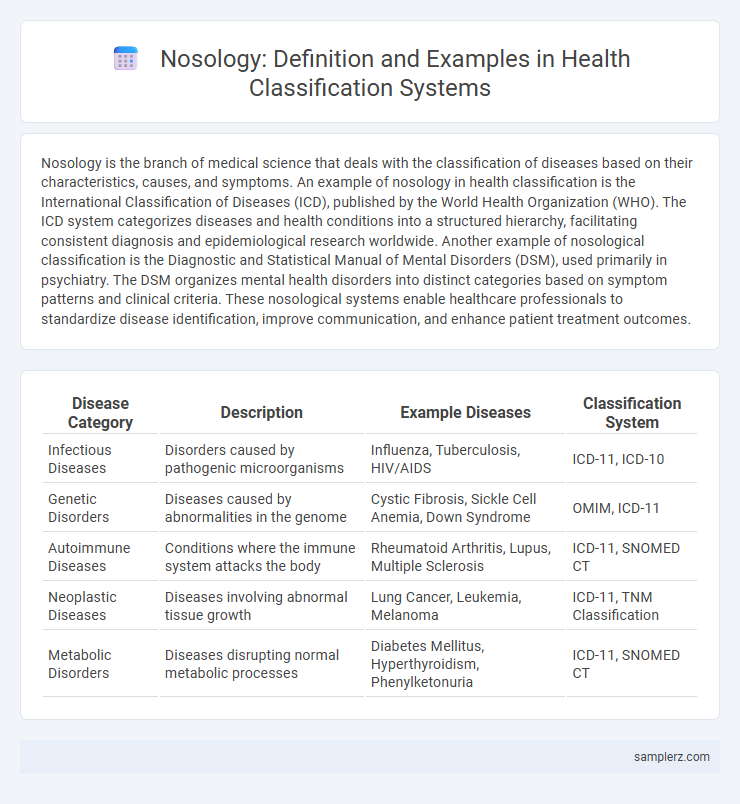Nosology is the branch of medical science that deals with the classification of diseases based on their characteristics, causes, and symptoms. An example of nosology in health classification is the International Classification of Diseases (ICD), published by the World Health Organization (WHO). The ICD system categorizes diseases and health conditions into a structured hierarchy, facilitating consistent diagnosis and epidemiological research worldwide. Another example of nosological classification is the Diagnostic and Statistical Manual of Mental Disorders (DSM), used primarily in psychiatry. The DSM organizes mental health disorders into distinct categories based on symptom patterns and clinical criteria. These nosological systems enable healthcare professionals to standardize disease identification, improve communication, and enhance patient treatment outcomes.
Table of Comparison
| Disease Category | Description | Example Diseases | Classification System |
|---|---|---|---|
| Infectious Diseases | Disorders caused by pathogenic microorganisms | Influenza, Tuberculosis, HIV/AIDS | ICD-11, ICD-10 |
| Genetic Disorders | Diseases caused by abnormalities in the genome | Cystic Fibrosis, Sickle Cell Anemia, Down Syndrome | OMIM, ICD-11 |
| Autoimmune Diseases | Conditions where the immune system attacks the body | Rheumatoid Arthritis, Lupus, Multiple Sclerosis | ICD-11, SNOMED CT |
| Neoplastic Diseases | Diseases involving abnormal tissue growth | Lung Cancer, Leukemia, Melanoma | ICD-11, TNM Classification |
| Metabolic Disorders | Diseases disrupting normal metabolic processes | Diabetes Mellitus, Hyperthyroidism, Phenylketonuria | ICD-11, SNOMED CT |
Understanding Nosology: The Foundation of Medical Classification
Nosology is the branch of medical science that deals with the systematic classification of diseases based on specific criteria such as etiology, pathology, and clinical features. An example of nosology in classification is the International Classification of Diseases (ICD), developed by the World Health Organization, which standardizes disease diagnosis and coding globally. This framework enhances accurate disease identification, epidemiological tracking, and health policy planning.
Historical Development of Nosological Systems
The historical development of nosological systems traces back to Hippocrates, who first categorized diseases based on symptom clusters, laying the groundwork for systematic disease classification. The 19th century saw the emergence of the International Classification of Diseases (ICD), pioneered by Jacques Bertillon, which standardized disease nomenclature globally. Modern nosology incorporates advances in genetics and molecular biology, refining disease categories to improve diagnosis and treatment efficacy.
Modern Examples of Nosology in Disease Classification
Modern examples of nosology in disease classification prominently include the International Classification of Diseases (ICD-11) maintained by the World Health Organization, which systematically categorizes over 55,000 codes for diseases, disorders, injuries, and other health conditions. The Diagnostic and Statistical Manual of Mental Disorders, Fifth Edition (DSM-5), extensively utilized in psychiatry, provides detailed criteria for classifying mental health disorders with an emphasis on clinical utility and research consistency. Advances in genomic medicine have also introduced molecular nosology, incorporating genetic markers to redefine disease categories, particularly in oncology and rare genetic disorders.
The International Classification of Diseases (ICD) as a Nosological Tool
The International Classification of Diseases (ICD) serves as a fundamental nosological tool by systematically categorizing diseases and health conditions through alphanumeric codes, facilitating consistent diagnosis and statistical analysis worldwide. This classification system, maintained by the World Health Organization (WHO), enables healthcare professionals to accurately record morbidity and mortality data, improving disease surveillance and health management. Its standardized structure supports global health initiatives, epidemiological research, and policy-making by providing a universal language for disease identification and reporting.
Nosology in Psychiatric Disorders: The DSM Approach
The Diagnostic and Statistical Manual of Mental Disorders (DSM) exemplifies nosology in psychiatric classification by systematically categorizing mental health conditions based on symptomatology and etiology. This framework enables clinicians to diagnose disorders such as major depressive disorder, schizophrenia, and bipolar disorder with standardized criteria, facilitating consistent treatment planning and research. The DSM's iterative revisions reflect ongoing advances in psychiatric knowledge, integrating neurobiological findings and epidemiological data to enhance diagnostic accuracy.
Genetic Nosology: Classifying Rare and Hereditary Diseases
Genetic nosology organizes rare and hereditary diseases based on genomic mutations, chromosomal abnormalities, and inheritance patterns. This classification aids in precise diagnosis, enabling targeted treatments and personalized patient care. Examples include cystic fibrosis, sickle cell anemia, and Huntington's disease, categorized by their specific gene mutations and genetic pathways.
Infectious Disease Nosology: Organizing Pathogens and Syndromes
Infectious disease nosology systematically classifies pathogens such as bacteria, viruses, fungi, and parasites based on their biological characteristics and modes of transmission. This approach enables precise identification of syndromes like respiratory infections, gastroenteritis, or vector-borne diseases, facilitating targeted treatment and public health interventions. Utilization of diagnostic codes like ICD-10 enhances data consistency for epidemiological tracking and clinical research.
Cancer Classification: Nosological Groupings in Oncology
Cancer classification within nosology organizes malignant tumors into specific groups based on histological origin, genetic mutations, and clinical behavior. Common nosological groupings in oncology include carcinomas, sarcomas, lymphomas, and leukemias, each representing distinct pathways of cellular transformation. This structured classification enhances the precision of diagnosis, prognosis, and personalized therapeutic strategies in cancer management.
The Role of Nosology in Chronic Disease Management
Nosology, the systematic classification of diseases, plays a critical role in chronic disease management by enabling precise diagnosis and tailored treatment plans. For example, the differentiation of diabetes into Type 1, Type 2, and gestational diabetes allows healthcare providers to apply targeted therapeutic strategies and monitor disease progression effectively. Accurate nosological classification enhances patient outcomes through personalized care and improved epidemiological tracking.
Future Directions: Digital Transformation in Nosological Systems
Digital transformation in nosological systems is revolutionizing health classification by integrating artificial intelligence and big data analytics to enhance disease diagnosis and categorization accuracy. Emerging technologies like machine learning enable dynamic updating of disease taxonomies based on real-time patient data, improving personalized medicine and predictive health outcomes. This future direction in nosology supports more precise epidemiological tracking and tailored treatment protocols, fostering advancements in global health management.

example of nosology in classification Infographic
 samplerz.com
samplerz.com